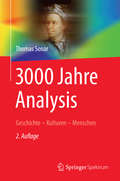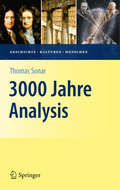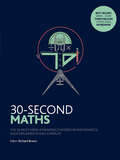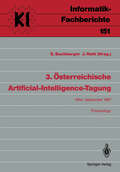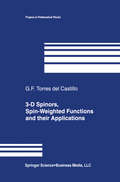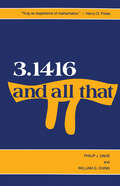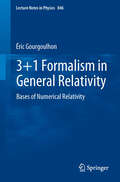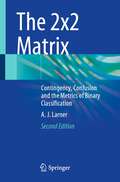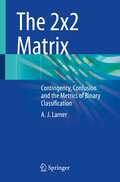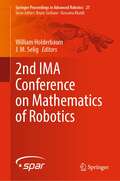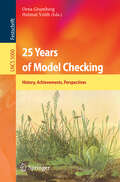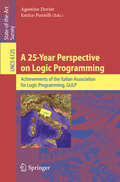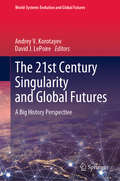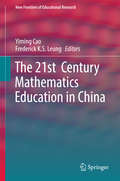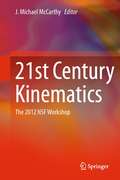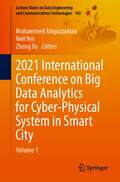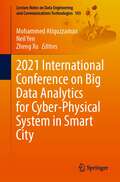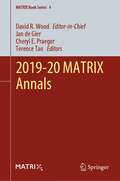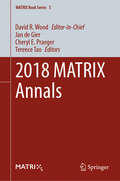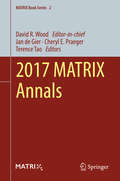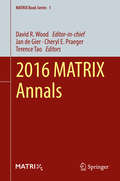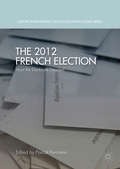- Table View
- List View
3000 Jahre Analysis: Geschichte - Kulturen - Menschen (Vom Zählstein zum Computer)
by Thomas SonarIn dem Band werden Entstehung und Entwicklung der grundlegenden Begriffe der Analysis von der Antike bis heute ausführlich behandelt. Eingebettet sind diese Informationen in die Beschreibung historischer und kultureller Ereignisse, die Lebensläufe bedeutender Mathematiker und der von ihnen entwickelten Teilgebiete der Analysis. Zahlreiche gezeichnete Figuren veranschaulichen Begriffe, Lehrsätze und Methoden. Jedes Kapitel enthält eine Tabelle mit den Daten der wesentlichen Ergebnisse und Ereignisse aus 3000 Jahren Analysis.
3000 Jahre Analysis: Geschichte, Kulturen, Menschen (Vom Zählstein zum Computer)
by Thomas SonarIn dem Band werden Entstehung und Entwicklung der grundlegenden Begriffe der Analysis von der Antike bis heute ausführlich behandelt. Eingebettet sind diese Informationen in die Beschreibung historischer und kultureller Ereignisse, die Lebensläufe bedeutender Mathematiker und der von ihnen entwickelten Teilgebiete der Analysis. Zahlreiche gezeichnete Figuren veranschaulichen Begriffe, Lehrsätze und Methoden. Jedes Kapitel enthält eine Tabelle mit den Daten der wesentlichen Ergebnisse und Ereignisse aus 3000 Jahren Analysis.
30 Years of Change for Children (PDF)
by Gillian PughHow well have children fared in the UK in the thirty years since the National Children's Bureau was established in 1963. How has family life changed? What have been the main social and demographic changes? Has the welfare state continued to provide education, health care and social welfare for all children? These and other questions are considered as the authors reflect on the main changes in legislation, on key messages from research and on whether developments in practice have reflected these research findings.
30-Second Maths: The 50 Most Mind-expanding Theories In Mathematics, Each Explained In Half A Minute (30-second Ser.)
by Richard BrownFrom Rubik's cubes to Godel's incompleteness theorem, everything mathematical explained, with colour illustrations, in half a minute. Maths is enjoying a resurgence in popularity. So how can you avoid being the only dinner guest who has no idea who Fermat was, or what he proved? The more you know about Maths, the less of a science it becomes. 30 Second Maths takes the top 50 most engaging mathematical theories, and explains them to the general reader in half a minute, using nothing more than two pages, 200 words and one picture. Read at your own pace, and discover that maths can be more fascinating than you ever imagined.
3. Österreichische Artificial-Intelligence-Tagung: Wien, 22–25. September 1987 (Informatik-Fachberichte #151)
by Ernst Buchberger Johannes Retti3-D Spinors, Spin-Weighted Functions and their Applications (Progress in Mathematical Physics #32)
by Gerardo F. Torres del CastilloThis book on the theory of three-dimensional spinors and their applications fills an important gap in the literature. It gives an introductory treatment of spinors. From the reviews: "Gathers much of what can be done with 3-D spinors in an easy-to-read, self-contained form designed for applications that will supplement many available spinor treatments. The book…should be appealing to graduate students and researchers in relativity and mathematical physics." -—MATHEMATICAL REVIEWS
3.1416 And All That
by DAVIS CHINNLYTTON STRACHEY tells the following story. In intervals of relaxation from his art, the painter Degas used to try his hand at writing sonnets. One day, while so engaged, he found that his in spiration had run dry. In desperation he ran to his friend Mallarme, who was a poet. "My poem won't come out," he said, "and yet I'm full of excellent ideas. " "My dear Degas," Mallarme retorted, "poetry is not written with ideas, it is written with words. " If we seek an application of Mallarme's words to mathematics we find that we shall want to turn his paradox around. We are led to say that mathematics does not consist of formulas, it consists of ideas. What is platitudinous about this statement is that mathe matics, of course, consists of ideas. Who but the most unregenerate formalist, asserting that mathematics is a meaningless game played with symbols, would deny it? What is paradoxical about the state ment is that symbols and formulas dominate the mathematical page, and so one is naturally led to equate mathematics with its formulas.
3+1 Formalism in General Relativity: Bases of Numerical Relativity (Lecture Notes in Physics #846)
by Éric GourgoulhonThis graduate-level, course-based text is devoted to the 3+1 formalism of general relativity, which also constitutes the theoretical foundations of numerical relativity. The book starts by establishing the mathematical background (differential geometry, hypersurfaces embedded in space-time, foliation of space-time by a family of space-like hypersurfaces), and then turns to the 3+1 decomposition of the Einstein equations, giving rise to the Cauchy problem with constraints, which constitutes the core of 3+1 formalism. The ADM Hamiltonian formulation of general relativity is also introduced at this stage. Finally, the decomposition of the matter and electromagnetic field equations is presented, focusing on the astrophysically relevant cases of a perfect fluid and a perfect conductor (ideal magnetohydrodynamics). The second part of the book introduces more advanced topics: the conformal transformation of the 3-metric on each hypersurface and the corresponding rewriting of the 3+1 Einstein equations, the Isenberg-Wilson-Mathews approximation to general relativity, global quantities associated with asymptotic flatness (ADM mass, linear and angular momentum) and with symmetries (Komar mass and angular momentum). In the last part, the initial data problem is studied, the choice of spacetime coordinates within the 3+1 framework is discussed and various schemes for the time integration of the 3+1 Einstein equations are reviewed. The prerequisites are those of a basic general relativity course with calculations and derivations presented in detail, making this text complete and self-contained. Numerical techniques are not covered in this book.
The 2x2 Matrix: Contingency, Confusion and the Metrics of Binary Classification
by A. J. LarnerThis book describes, extends, and illustrates the metrics of binary classification through worked examples.Worked examples based on pragmatic test accuracy study data are used in chapters to illustrate relevance to day-to-day clinical practice. Readers will gain an understanding of sensitivity and specificity and predictive values along with many other parameters.The contents are highly structured, and the use of worked examples facilitates understanding and interpretation.This book is a resource for clinicians in any discipline who are involved in the performance or assessment of test accuracy studies and professionals in the disciplines of machine learning or informatics wishing to gain insight into clinical applications of 2x2 tables.
The 2x2 Matrix: Contingency, Confusion and the Metrics of Binary Classification
by A.J. LarnerThis book presents and discusses the numerous measures of test performance that can be derived from 2x2 tables. Worked examples based on pragmatic test accuracy study data are used in chapters to illustrate relevance to day-to-day clinical practice. Readers will gain a good understanding of sensitivity and specificity and predictive values along with many other parameters.The contents are highly structured and the use of worked examples facilitates understanding and interpretation. This book is a resource for clinicians in any discipline who are involved in the performance or assessment of test accuracy studies, and professionals in the disciplines of machine learning or informatics wishing to gain insight into clinical applications of 2x2 tables.
2nd IMA Conference on Mathematics of Robotics (Springer Proceedings in Advanced Robotics #21)
by William Holderbaum J. M. SeligThis book highlights the mathematical depth and sophistication of techniques used in different areas of robotics. Each chapter is a peer-reviewed version of a paper presented during the 2021 IMA Conference on the Mathematics of Robotics, held online September 8–10, 2021. The conference gave a platform to researchers with fundamental contributions and for academic and to share new ideas. The book illustrates some of the current interest in advanced mathematics and robotics such as algebraic geometry, tropical geometry, monodromy and homotopy continuation methods applied to areas such as kinematics, path planning, swam robotics, dynamics and control. It is hoped that the conference and this publications will stimulate further related mathematical research in robotics.
25 Years of Model Checking: History, Achievements, Perspectives (Lecture Notes in Computer Science #5000)
by Orna Grumberg Helmut VeithModel checking technology is among the foremost applications of logic to computer science and computer engineering. The model checking community has achieved many breakthroughs, bridging the gap between theoretical computer science and hardware and software engineering, and it is reaching out to new challenging areas such as system biology and hybrid systems. Model checking is extensively used in the hardware industry and has also been applied to the verification of many types of software. Model checking has been introduced into computer science and electrical engineering curricula at universities worldwide and has become a universal tool for the analysis of systems. This Festschrift volume, published in celebration of the 25th Anniversary of Model Checking, includes a collection of 11 invited papers based on talks at the symposium "25 Years of Model Checking", 25MC, which was part of the 18th International Conference on Computer Aided Verification (CAV 2006), which in turn was part of the Federated Logic Conference (FLoC 2006) held in Seattle, WA, USA, in August 2006. Model checking is currently attracting considerable attention beyond the core technical community, and the ACM Turing Award 2007 was given in recognition of the paradigm-shifting work on this topic initiated a quarter century ago. Here we honor that achievement with the inclusion of facsimile reprints of the visionary papers on model checking by Edmund Clarke and Allen Emerson, and by Jean-Pierre Queille and Joseph Sifakis.
A 25-Year Perspective on Logic Programming: Achievements of the Italian Association for Logic Programming, GULP (Lecture Notes in Computer Science #6125)
by Agostino Dovier Enrico PontelliThis book celebratesthe 25th anniversaryof GULP—the Italian Associationfor LogicProgramming.Authored by Italian researchersat the leading edge of their ?elds, it presents an up-to-date survey of a broad collection of topics in logic programming, making it a useful reference for both researchers and students. During its 25-year existence, GULP has organised a wide range of national and international activities, including both conferences and summer schools. It has been especially active in supporting and encouraging young researchers, by providing scholarships for GULP events and awarding distinguished disser- tions. WeintheinternationallogicprogrammingcommunitylookuponGULPwith a combination of envy, admiration and gratitude. We are pleased to attend its conferences and summer schools, where we can learn about scienti?c advances, catch up with old friends and meet young students. It is an honour for me to acknowledge our appreciation to GULP for its outstanding contributions to our ?eld and to express our best wishes for its continuing prosperity in the future. March 2010 Robert Kowalski Imperial College London Preface On June 18, 1985, a group of pioneering researchers, including representatives from industry, national research labs, and academia, attended the constituent assembly of the Group of researchers and Users of Logic Programming (GULP) association. That was the starting point of a long adventure in science, that 1 we are still experiencing 25 years later. This volume celebrates this important event.
24 x 12 grid (tactile)
by Adrian FarnsworthThis page shows an image of a grid made up of many small squares.
24 x 12 grid (Tactile)
by Adrian FarnsworthThis page shows an image of a grid made up of many small squares.
The 21st Century Singularity and Global Futures: A Big History Perspective (World-Systems Evolution and Global Futures)
by Andrey V. Korotayev David J. LePoireThis book introduces a 'Big History' perspective to understand the acceleration of social, technological and economic trends towards a near-term singularity, marking a radical turning point in the evolution of our planet. It traces the emergence of accelerating innovation rates through global history and highlights major historical transformations throughout the evolution of life, humans, and civilization. The authors pursue an interdisciplinary approach, also drawing on concepts from physics and evolutionary biology, to offer potential models of the underlying mechanisms driving this acceleration, along with potential clues on how it might progress. The contributions gathered here are divided into five parts, the first of which studies historical mega-trends in relation to a variety of aspects including technology, population, energy, and information. The second part is dedicated to a variety of models that can help understand the potential mechanisms, and support extrapolation. In turn, the third part explores various potential future scenarios, along with the paths and decisions that are required. The fourth part presents philosophical perspectives on the potential deeper meaning and implications of the trend towards singularity, while the fifth and last part discusses the implications of the Search for Extraterrestrial Intelligence (SETI). Given its scope, the book will appeal to scholars from various disciplines interested in historical trends, technological change and evolutionary processes.
The 21st Century Mathematics Education in China (New Frontiers of Educational Research)
by Yiming Cao Frederick K.S. LeungThis book intends to provide a comprehensive introduction to the status of development of Chinese mathematics education in the 21st century. To this end, the book summarizes and presents the research and practices of Chinese mathematics education in the following aspects: (1) characteristics of Chinese school mathematics curriculum and textbooks, (2) Chinese ways and strategies of teaching mathematics and the characteristics of mathematics classroom instruction in China, (3) Chinese instructional practices in developing (both gifted and underachieving) students’ mathematical capabilities, (4) how professional development of mathematics teachers is promoted in China, including mathematics teachers’ pre-service and in-service education, and how Chinese mathematics teachers design and implement teaching and research activities, and (5) how mathematics education is assessed and evaluated, including how to evaluate teachers’ teaching and students’ achievements. Relevant research in Chinese mathematics education involving methods of surveys, interviews, text analysis, etc., are reviewed and analyzed. Results of a number of video studies of Chinese mathematics classroom teaching and learning are also integrated into this book.
21st Century Kinematics: The 2012 NSF Workshop
by J. Michael McCarthy21st Century Kinematics focuses on algebraic problems in the analysis and synthesis of mechanisms and robots, compliant mechanisms, cable-driven systems and protein kinematics. The specialist contributors provide the background for a series of presentations at the 2012 NSF Workshop. The text shows how the analysis and design of innovative mechanical systems yield increasingly complex systems of polynomials, characteristic of those systems. In doing so, it takes advantage of increasingly sophisticated computational tools developed for numerical algebraic geometry and demonstrates the now routine derivation of polynomial systems dwarfing the landmark problems of even the recent past. The 21st Century Kinematics workshop echoes the NSF-supported 1963 Yale Mechanisms Teachers Conference that taught a generation of university educators the fundamental principles of kinematic theory. As such these proceedings will provide admirable supporting theory for a graduate course in modern kinematics and should be of considerable interest to researchers in mechanical design, robotics or protein kinematics or who have a broader interest in algebraic geometry and its applications.
2021 International Conference on Big Data Analytics for Cyber-Physical System in Smart City: Volume 1 (Lecture Notes on Data Engineering and Communications Technologies #102)
by Mohammed Atiquzzaman Neil Yen Zheng XuThis book gathers a selection of peer-reviewed papers presented at the third Big Data Analytics for Cyber-Physical System in Smart City (BDCPS 2021) conference, held in Shanghai, China, on Nov. 27, 2021. The contributions, prepared by an international team of scientists and engineers, cover the latest advances made in the field of machine learning, and big data analytics methods and approaches for the data-driven co-design of communication, computing, and control for smart cities. Given its scope, it offers a valuable resource for all researchers and professionals interested in big data, smart cities, and cyber-physical systems.
2021 International Conference on Big Data Analytics for Cyber-Physical System in Smart City: Volume 2 (Lecture Notes on Data Engineering and Communications Technologies #103)
by Mohammed Atiquzzaman Neil Yen Zheng XuThis book gathers a selection of peer-reviewed papers presented at the third Big Data Analytics for Cyber-Physical System in Smart City (BDCPS 2021) conference, held in Shanghai, China, on Nov. 27, 2021. The contributions, prepared by an international team of scientists and engineers, cover the latest advances made in the field of machine learning, and big data analytics methods and approaches for the data-driven co-design of communication, computing, and control for smart cities. Given its scope, it offers a valuable resource for all researchers and professionals interested in big data, smart cities, and cyber-physical systems.
2019-20 MATRIX Annals (MATRIX Book Series #4)
by David R. WoodMATRIX is Australia’s international and residential mathematical research institute. It facilitates new collaborations and mathematical advances through intensive residential research programs, each 1-4 weeks in duration. This book is a scientific record of the ten programs held at MATRIX in 2019 and the two programs held in January 2020: · Topology of Manifolds: Interactions Between High and Low Dimensions· Australian-German Workshop on Differential Geometry in the Large· Aperiodic Order meets Number Theory· Ergodic Theory, Diophantine Approximation and Related Topics· Influencing Public Health Policy with Data-informed Mathematical Models of Infectious Diseases· International Workshop on Spatial Statistics· Mathematics of Physiological Rhythms· Conservation Laws, Interfaces and Mixing· Structural Graph Theory Downunder· Tropical Geometry and Mirror Symmetry· Early Career Researchers Workshop on Geometric Analysis and PDEs· Harmonic Analysis and Dispersive PDEs: Problems and ProgressThe articles are grouped into peer-reviewed contributions and other contributions. The peer-reviewed articles present original results or reviews on a topic related to the MATRIX program; the remaining contributions are predominantly lecture notes or short articles based on talks or activities at MATRIX.
2018 MATRIX Annals (MATRIX Book Series #3)
by David R. WoodMATRIX is Australia’s international and residential mathematical research institute. It facilitates new collaborations and mathematical advances through intensive residential research programs, each 1-4 weeks in duration. This book is a scientific record of the eight programs held at MATRIX in 2018: - Non-Equilibrium Systems and Special Functions- Algebraic Geometry, Approximation and Optimisation- On the Frontiers of High Dimensional Computation- Month of Mathematical Biology- Dynamics, Foliations, and Geometry In Dimension 3- Recent Trends on Nonlinear PDEs of Elliptic and Parabolic Type- Functional Data Analysis and Beyond- Geometric and Categorical Representation Theory The articles are grouped into peer-reviewed contributions and other contributions. The peer-reviewed articles present original results or reviews on a topic related to the MATRIX program; the remaining contributions are predominantly lecture notes or short articles based on talks or activities at MATRIX.
2017 MATRIX Annals (MATRIX Book Series #2)
by David R. Wood Jan De Gier Cheryl E. Praeger Terence TaoMATRIX is Australia’s international and residential mathematical research institute. It facilitates new collaborations and mathematical advances through intensive residential research programs, each 1-4 weeks in duration. This book is a scientific record of the eight programs held at MATRIX in its second year, 2017: - Hypergeometric Motives and Calabi–Yau Differential Equations- Computational Inverse Problems- Integrability in Low-Dimensional Quantum Systems- Elliptic Partial Differential Equations of Second Order: Celebrating 40 Years of Gilbarg and Trudinger’s Book- Combinatorics, Statistical Mechanics, and Conformal Field Theory- Mathematics of Risk- Tutte Centenary Retreat- Geometric R-Matrices: from Geometry to ProbabilityThe articles are grouped into peer-reviewed contributions and other contributions. The peer-reviewed articles present original results or reviews on a topic related to the MATRIX program; the remaining contributions are predominantly lecture notes or short articles based on talks or activities at MATRIX.
2016 MATRIX Annals (MATRIX Book Series #1)
by David R. Wood Jan De Gier Cheryl E. Praeger Terence TaoMATRIX is Australia’s international, residential mathematical research institute. It facilitates new collaborations and mathematical advances through intensive residential research programs, each lasting 1-4 weeks. This book is a scientific record of the five programs held at MATRIX in its first year, 2016: - Higher Structures in Geometry and Physics - Winter of Disconnectedness - Approximation and Optimisation - Refining C*-Algebraic Invariants for Dynamics using KK-theory - Interactions between Topological Recursion, Modularity, Quantum Invariants and Low- dimensional Topology The MATRIX Scientific Committee selected these programs based on their scientific excellence and the participation rate of high-profile international participants. Each program included ample unstructured time to encourage collaborative research; some of the longer programs also included an embedded conference or lecture series.The articles are grouped into peer-reviewed contributions and other contributions. The peer-reviewed articles present original results or reviews on selected topics related to the MATRIX program; the remaining contributions are predominantly lecture notes based on talks or activities at MATRIX.
The 2012 French Election: How the Electorate Decided (Europe in Transition: The NYU European Studies Series)
by Pascal PerrineauThis edited volume is based on a highly original survey carried out between November 2011 and June 2012 among a panel of 6,000 voters. The panel was interviewed on 12 separate occasions about how and why they made their voting choices. The book focuses on how electoral choices are made and how these choices evolve during the short time-span of an election campaign. The analysis of the 2012 electoral result shows more than ever that voting choices are the fruit of interweaving timelines: the long term period that characterizes voters’ predispositions and their predictions of a possible scenario; the shorter period of time during which the campaign unfolds where those predispositions are either confirmed, called into question, or undone; and the moment when the final choice is made. This is the first time the electoral decision-making process during a French Presidential election has been systematically studied.
